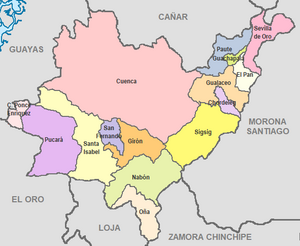Azuay Province
|
||
|---|---|---|
| flag | ||

|
||
| Location in Ecuador | ||
| Basic data | ||
| Capital | Cuenca | |
| population | 712,127 (2010) | |
| - Share in Ecuador | 5.0% | |
| - Rank in Ecuador | 5 of 22 | |
| - density | 86 inhabitants per km² | |
| surface | 8,309.58 km² | |
| - Share in Ecuador | 3.0% | |
| - Rank in Ecuador | 13 of 22 | |
| License Plate | A. | |
| Set up | 1824 | |
| prefect | Paúl Carrasco ( Participa, Democracia Radical ) | |
| governor | Xavier Maurico Enderica | |
| Seats in the National Congress |
5 out of 100 | |
| structure | 15 cantons | |
| ISO 3166-2 | EC-A | |
Azuay ( Spanish Provincia del Azuay ) is a province in Ecuador . It is located in the southern Andean highlands ( Sierra ) of the country, is 8310 km² in size and has about 712,000 inhabitants. In the province of Azuay there are mountains of up to 4500 meters. The capital is Cuenca .
Location and geography
Azuay is located in the southern part of the Ecuadorian Andean region, which is called the Sierra . It borders the Cañar Province to the north, the Morona Santiago Province to the east, the Zamora Chinchipe and Loja provinces to the south, and El Oro and Guayas to the west . The Panamericana runs through the province in a north-south direction . Important rivers are the Río Tomebamba , the Río Tarqui and the Río Paute . The largest hydroelectric power station in the country, the Amaluza Dam (also known as the "Daniel Palacios Dam") is located on the latter .
The Cajas National Park with mountains up to 4500 m high is located in the province of Azuay.
politics
Prefect of the province has been Paúl Carrasco since 2005, who initially belonged to the social democratic party Izquierda Democrática and founded his own citizens' movement Movimiento Encuentro Democrático in 2007 , which was renamed Participa, Democracia Radical in 2012 . Since the regional elections, this movement has provided the mayors of five of the province's 15 canton capitals, including the capital Cuenca, either alone or in electoral alliances. The Ecuadorian ruling party Alianza PAÍS has five more mayors.
history
Through the law on the territorial division (Spanish: Ley de División Territorial ) of Greater Colombia of June 25, 1824, the Departamento del Azuay with capital in Cuenca, which comprised three provinces , was created on older bases : Azuay with capital Cuenca, Loja with capital Loja and Jaén de Bracamoros and Mainas (Amazonian provinces ) with capital Jaén . This roughly corresponds to the area of the present-day provinces of Cañar, Loja, El Oro, Morona Santiago and Zamora Chinchipe as well as most of the eastern national territory lost to Peru in 1904 and after the Peruvian-Ecuadorian War in the Protocol of Río de Janeiro in 1942 .
The province of Cañar was spun off from the province of Cuenca itself in 1880.
The name Azuay comes from the language of the Kañari , whose main settlement was the region around Cuenca.
Cantons
The province is currently divided into 15 cantons . These are (in order of their establishment):
- Cuenca (established in 1824, capital: Cuenca )
- Gualaceo (established in 1824; capital: Gualaceo )
- Paute (established in 1860, capital: Paute )
- Sígsig (established in 1864, capital: Sígsig )
- Girón (established in 1884, capital Girón ; the canton of Girón was established for the first time in 1824 and in the early 1850s, but dissolved again in 1854)
- Santa Isabel (established in 1945, capital: Santa Isabel )
- San Fernando (established in 1986, capital: San Fernando)
- Nabón (established in 1987, capital: Nabón)
- Pucará (established in 1988, capital: Pucará)
- Oña (established in 1991, capital: Oña)
- Chordeleg (established in 1992, capital: Chordeleg)
- El Pan (established in 1992, capital: El Pan)
- Sevilla de Oro (established in 1992, capital: Sevilla de Oro; probably named after the Spanish settlement Sevilla de Oro, which was destroyed in 1599 )
- Guachapala (established in 1996, capital: Guachapala)
- Ponce Enríquez (established: 2002, capital: Ponce Enríquez; Camilo Ponce Enríquez (1912–1976) was President of Ecuador from 1956 to 1960)
Web links
- cuencanos.com - Description of the cantons of Azuays (Spanish) ( Memento from February 8, 2008 in the Internet Archive )
Individual evidence
- ^ INEC, Población total y tasa brutas de natalidad, mortalidad general, mortalidad infantil y materna según regiones y provincias de residencia habitual, año 2010 ( memento of June 8, 2006 in the Internet Archive ), accessed on October 13, 2010.
Coordinates: 3 ° 3 ′ S , 79 ° 14 ′ W



